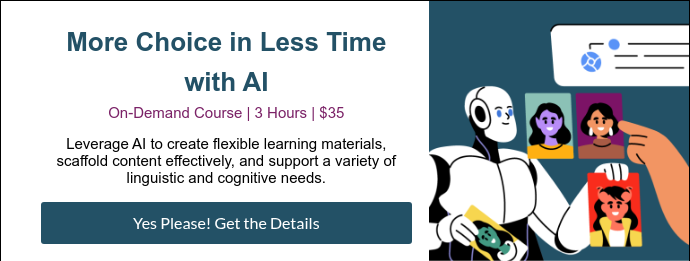Meeting the needs of all learners is a challenge, but generative AI can be a powerful tool to help teachers balance the demands of teaching and learning. From personalized feedback to customized learning resources, AI can enhance instruction while giving teachers more time to focus on students.
Here are ten ways AI can support diverse learners in the classroom:
1. Provide Action-Oriented Feedback
High-quality feedback is crucial for effective learning, but it can be time-consuming. AI tools like Brisk streamline this process by aligning feedback with rubrics and state standards in over 20 languages. Teachers can use AI-generated comments or personalize them to fit each student’s needs.
Brisk AI offers four distinct feedback options: targeted feedback, glow and grow, rubric criteria, and next steps—allowing you to tailor responses to your students' needs. This flexibility ensures feedback aligns with your teaching style while supporting student growth. For example, students can upload an existing rubric to Brisk AI and generate specific, actionable insights to refine their writing.
Brisk AI can be a valuable tool for refining instructional materials and assessments. Use it to review and enhance assignments by ensuring they are clear, aligned with learning objectives, and accessible to all learners. Additionally, Brisk AI can help generate rubrics for upcoming assignments, providing students with clear expectations and criteria for success.
2. Create Custom Reading Passages
AI tools like Diffit allow teachers to generate personalized reading passages on any topic. These tools offer vocabulary support, quizzes, and translation options, making it easier for teachers to tailor content to individual learners and adjust reading levels as needed.
Teachers can use Diffit’s tools to customize reading materials for students that are tailored to their learning needs and preferences. In addition, Drift can built-in vocabulary support to enhance comprehension, and access translations to read in their preferred language.
3. Customize Math Word Problems
With AI tools like Copilot, Gemini, or ChatGPT, teachers can adapt math word problems while keeping the same numbers and answers. This customization ensures problems align with students’ backgrounds and learning goals.
For example, you could use generative AI to customize word problems based on student needs or preferences. Sample prompt:
Rewrite the following math word problem to reflect a different cultural context. Keep the same numbers and answer, but replace the name with an appropriate name from [insert cultural group] and change the objects to culturally relevant items (e.g., foods, animals, everyday objects, etc.). Do not include colors in the rewritten problem. The original problem is: [Insert original problem here with numbers and answer, e.g.,]
4. Offer Text-to-Speech Options
Reading support tools such as Natural Reader, Microsoft’s Immersive Reader, and Speechify use text-to-speech technology, providing students with an alternative way to access reading materials.
Tools like Natural Reader, Microsoft’s Immersive Reader, and Speechify enhance accessibility by using text-to-speech technology. For example, if students are reading a blog post, they can use Natural Reader to create an Immersive Reader experience, reducing distractions and simplifying the webpage. The MP3 feature also allows students to download an audio version of the text, giving them flexibility in how they engage with reading materials.
5. Use AI-Powered Chatbots for Tutoring
Custom AI chatbots, available through platforms like Magic School AI, Eduaide, or School AI, offer students an interactive way to ask questions and receive immediate feedback. This support can free up teacher time while ensuring students remain engaged in learning.
For instance, Magic School’s Raina Chatbot is an ideal tool for guiding students through math problems, historical concepts, language skills, and specific questions. Raina provides personalized, tailored feedback and is available beyond school hours, encouraging independent learning and boosting student confidence.
Teachers also benefit from chatbots by streamlining administrative tasks and offering more personalized support. These chatbots can handle common questions, share extra resources, and direct students to helpful materials, allowing teachers to focus on individualized instruction. Additionally, AI chatbots can identify learning gaps and offer valuable insights for lesson planning, ensuring every student gets the support they need.
6. Develop AI-Assisted Formative Assessments
Tools like the Snorkl app enable students to record their responses to math, ELA, and other subjects while AI analyzes their answers. Teachers receive AI-generated feedback, class performance insights, and the option to add personalized feedback.
Snorkl provides immediate feedback to students, keeping them engaged and helping them deepen their understanding. It also offers a range of tools for students to demonstrate their knowledge, enhancing learning with high-quality feedback on their verbal and visual explanations.
This process gives teachers valuable AI-generated insights into class performance, identifying trends and areas where students might need extra support, while still allowing for personalized teacher feedback.
7. Create Choice Boards for Self-Differentiation
AI tools like Gemini, Copilot, and Magic School AI help generate choice boards with multiple assignment options. Providing students with choices increases engagement and allows them to demonstrate learning in ways that best suit them.
Offering choice is a powerful strategy to increase student engagement. Research suggests that the most effective number of options is between 2 and 4. Choice boards are an excellent tool for promoting self-differentiation, enabling students to select the approach that aligns with their strengths, preferences, and needs. Whether through different formats, levels of difficulty, or types of content, choice boards encourage autonomy and empower students to take ownership of their learning.
8. Use AI for Language Translation
AI-powered translation tools, such as Papago, help multilingual learners by translating text, teacher instructions, or feedback into their preferred language. Canva’s translation feature can also convert images and documents into multiple languages, fostering accessibility.
Papago can assist multilingual learners by translating text, teacher instructions, and feedback into their preferred languages. It automatically detects the language of the input text and translates it into another language, helping students better understand the material. Additionally, it offers text-to-speech options, allowing students to listen to the translations, which further enhances their comprehension.
Teachers can utilize Papago to translate worksheets, handouts, and other classroom materials into multiple languages, making learning more accessible for students who are still developing their English proficiency. Additionally, teachers can create multilingual vocabulary lists and flashcards using Papago, which helps students learn key terms in both their native language and English.
9. Generate AI-Powered Quizzes and Practice Exercises
Teachers can use Quizizz to create quizzes from text prompts, PDFs, or PowerPoint files, with features for translation and difficulty adjustments. Magic School AI is another great tool, offering multiple-choice assessment generators, helping educators create personalized assessments efficiently.
Quizizz AI can analyze a student's performance on quizzes and develop targeted questions to adjust the difficulty of subsequent questions:
- If a student is struggling, the AI can adjust questions to reinforce foundational concepts.
- If a student is excelling, the AI will introduce more challenging material.
- Quizizz's AI-driven insights create personalized learning paths, adapting quizzes and assignments to students' individual progress, helping them focus on areas where they need the most practice.
Teachers can leverage Quizizz as a tool to help save time on assessment creation by inputting a topic, uploading a document (like a PDF or Word file) or providing a link to a website or video, and Quizizz AI will generate relevant quiz questions. For instance, a history teacher could upload a chapter from a textbook, and the AI would generate questions covering the key concepts. Once outputted, you can adjust as you see fit and check for accuracy.
10. Encourage Creativity with AI-Generated Content
AI-powered tools like Magic School, Canva, and Adobe Express allow students to generate images, videos, and interactive content. Platforms like Suno even enable students to create songs with AI-generated music, promoting creativity and self-expression.
Students can use Suno to enhance their learning by producing songs that help them remember key facts, formulas, or historical dates, such as a song about the order of the planets or the periodic table. This approach is especially beneficial for subjects that require rote memorization.
Teachers can also leverage Suno to create songs that introduce new topics, capturing students' attention and setting the stage for learning. Another way I love to use Suno is to design musical summaries of lessons, reinforcing important concepts in a fun and memorable way.
By embracing AI as a supportive tool, educators can create more accessible and engaging learning environments that cater to diverse student needs. Whether it's offering personalized feedback, generating adaptive learning materials, or providing multilingual support, AI empowers teachers to enhance their instructional strategies. As technology continues to evolve, integrating AI thoughtfully will help ensure that every student has the opportunity to succeed while allowing teachers to focus on building meaningful connections and fostering a love for learning.




